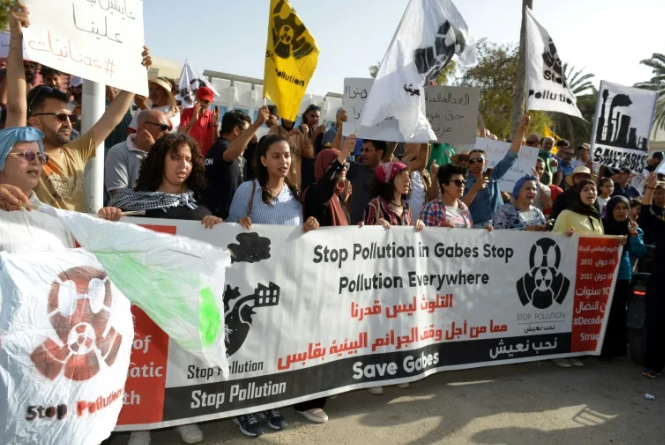Cherifa Attia’s room smells of burnt rubber. The odor comes from a massive phosphate processing plant located in Gabès, Tunisia, which releases its waste openly into the air and the sea.
For years, local residents have denounced the toxic emissions from the Tunisian Chemical Group (GCT), the country’s largest complex, which produces phosphate-based fertilizers.
Authorities had announced the plant’s closure in 2017, but the government recently pledged to quintuple phosphate production, increasing it from 3 million to 14 million tons annually by 2030.
« It’s killing us, we breathe this day and night, » Cherifa, 74, told AFP as she inhaled the acrid air enveloping Gabès and its 400,000 inhabitants.
After years of social unrest and underinvestment, President Kais Saied aims to revive the phosphate sector — Tunisia’s main natural resource — which has fallen from fifth largest global producer in 2010 to tenth today.
« This factory is harmful to the air, the sea, all forms of life. We hoped the 2017 closure decision would be enforced, but the government has clearly abandoned that idea, » laments Khayreddine Debaya, coordinator of Stop Pollution, a local NGO.
Cherifa says she survived two cancers — breast and uterine — while her sister Naftia, 76, suffers from heart and skin problems.
Various studies link phosphate processing to illnesses similar to those of the two sisters.
“Devastating Consequences”
Beyond ramping up production, the government recently decided to remove phosphogypsum — the main waste byproduct of fertilizer production — from the list of hazardous waste.
Fertilizer production emits highly toxic gases like sulfur dioxide and ammonia, while phosphogypsum contaminates soil and groundwater with carcinogens such as lead and arsenic.
The U.S. National Institute of Health has established a correlation between exposure to these wastes and ailments like liver failure, autoimmune diseases, and lung disorders.
According to a study by the French university laboratory Géosciences Environnement Toulouse published last December, the Gabès plant emits “very high levels” of pollutants.
The report deplores “devastating consequences” such as “cardiac malformations” and highlights that “this industrial pollution (…) is associated with various widespread health problems in Gabès, including cancers (lung, nose, breast, liver, kidney, stomach, blood).”
In the absence of official data, it is difficult to quantify the scale of the phenomenon. A local oncologist interviewed by AFP declined to comment on specific cases in Gabès. Many residents believe that some doctors’ caution is due to fear of government retaliation.
The chemical complex provides jobs to about 4,000 people in Gabès, where one in four is unemployed.
« If authorities refuse to dismantle it, at least they should stop dumping waste into the air and sea, » says Mouna Bouali, another 45-year-old resident, suggesting that authorities use phosphate revenues to “clean up the environment.”
Repeated requests for comment from authorities to AFP went unanswered.
“Our Loss”
« We are all dying in Gabès, » says Ms. Bouali, sitting next to her mother Dhabia, who is blind and suffers from an autoimmune disease.
« Let them take all of Gabès; we no longer want this city, » says Dhahbia, 67, who plans to sell her house but wonders, “who would want to buy a home here?”
In recent weeks, hundreds of residents have protested outside the local governor’s offices, holding signs reading: “I want to live.”
Families interviewed by AFP had voted for President Saied, re-elected last October, and they trust him. Yet it is under his leadership that Tunisia is betting on phosphate — a “pillar of the national economy,” according to Saied — to boost growth through exports mainly aimed at European markets.
Cherifa and Naftia still remember the inauguration of the GCT complex by Tunisia’s first president, Habib Bourguiba, in 1972, during a period of industrial growth. “We took to the streets to sing and applaud,” recalls Naftia, unaware that “we were celebrating our own loss.”
Source: fr.news


